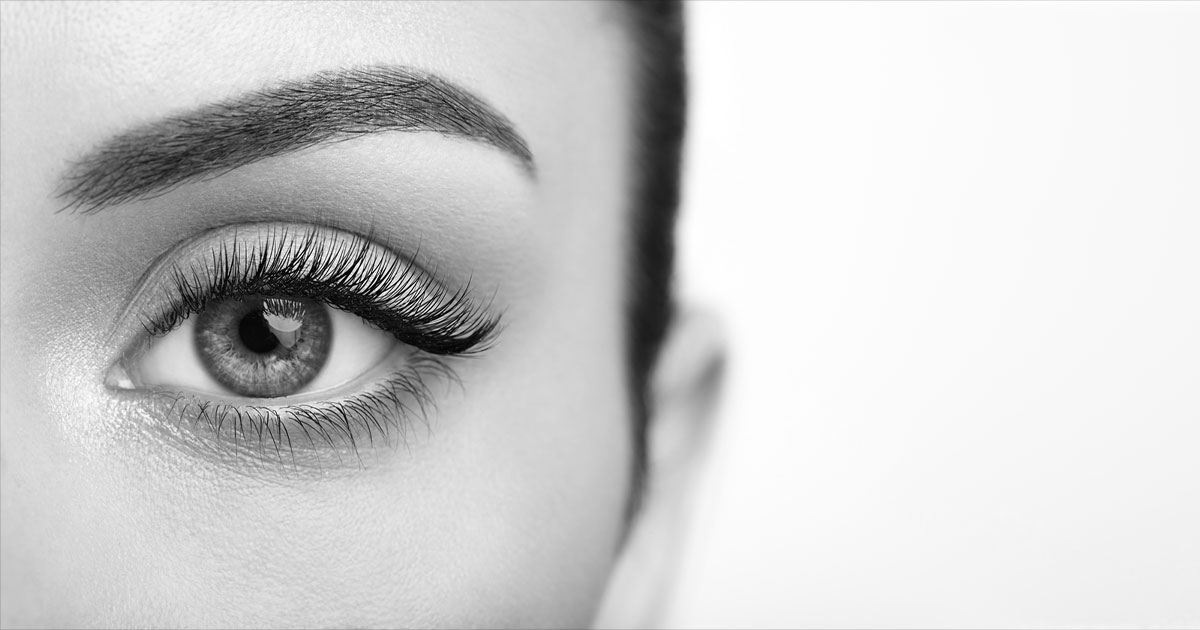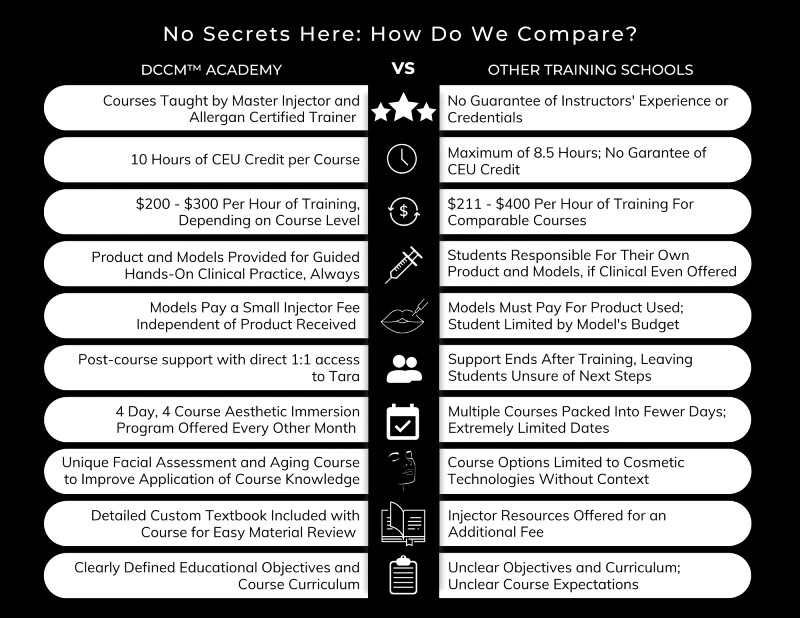PREVENTING AND TREATING EYELID PTOSIS
TREAT DROOPY EYELIDS AFTER BOTOX
Eyelid ptosis, otherwise known as blepharoptosis, can be a natural occurrence in the aging process. Eyelid ptosis can also be mechanically triggered by improper placement of neurotoxins such as Botox, Dysport, Xeomin, Daxi, and Jeuveau in the upper third of the face. Although medical providers, including aesthetic injectors, understand the medical terms eyelid ptosis and or blepharoptosis, the average person will understand this phenomenon as a droopy eyelid or a heavy eyelid. The word ptosis stems from the Greek meaning falling and is translated into medical terminology as droopy (King, 2016). This aesthetic problem can be not only physically damaging to patients but can be psychologically damaging as well.
When an injector causes eyelid ptosis, knowing to correct the ptosis is equally as important as being able to nurture the relationship based on trust and respect. The goal is to provide injectors with the knowledge to prevent adverse events; however, if an adverse event should arise, aesthetic injectors must be able to manage the complication. When blepharoptosis occurs after an aesthetic treatment, it is most commonly attributed to the spreading of neurotoxin through the fascia of the orbital septum to the levator palpebrae superioris muscle in the upper eyelid often due to the application of neurotoxins outside the safe zone or due to marked dispersion of the neurotoxin from excessive manipulation of the region.
Eyelid ptosis occurs in 5.4% of novice injector’s neurotoxin injections resulting from neurotoxin spread from the brow area to the levator palpebrae superioris muscle (King, 2016; Nestor et al., 2021). The rate of eyelid ptosis drops to less than 1% with treatment by an experienced aesthetic injector (Nestor et al., 2021). Education is paramount in patient safety in any field of medicine; however, it is even more imperative in aesthetic medicine, given that this niche field of medicine is highly unregulated.
Eyelid ptosis can impact patients, their love life, their ability to work, and even drive a vehicle. The condition mimics having a stroke or what some may know as Guillain Barre Syndrome. The overwhelming impact this condition can have on a patient’s entire life will likely have a negative impact on an injector’s business regarding the potential litigation due to medical liability. Injectors must understand the anatomical nature of the area they are treating to reduce the risk of this adverse complication.
Beyond a comprehensive understanding of anatomy, injectors must also understand how to provide informed consent beyond the legal document the patient signs. Informed consent, patient selection, a comprehensive understanding of the drugs being used, and a comprehensive knowledge base of human anatomy, coupled with proper technique, are imperative for aesthetic injectors.
Should a complication arise, one must possess an intimate knowledge of the human body beyond cosmetic medicine to be able to diagnose correctly and to be able to treat the adverse event successfully. Given the emotional impact one physical deformity can have on a patient’s mental well-being, an aesthetic injector must be able to nurture the relationship in order to stay in control of the patient’s physical and mental well-being.
There are five known classifications of eyelid ptosis: neurogenic, myogenic, aponeurotic, mechanical, and traumatic. Eyelid ptosis induced by neurotoxins classified as myogenic is due to impairment of the transmission of electrical impulses at the neuromuscular junction. The remainder of this section on eyelid ptosis will focus on the idea of a myogenic complication.
Learning Goals for Aesthetic Injectors to Mitigate and Manage Complications:
- Learn how to reduce the risk of eyelid ptosis
- Learn techniques and anatomy harmoniously to recognize how technology plays a role in outcomes
- Learn how to treat eyelid ptosis and reduce the symptoms
- Learn how to explain the diagnosis and the management plan to your patient to reduce stress and anxiety, creating a smooth transition to resolution.
Anatomy

For the neurotoxin to get to this highly protected area, the neurotoxin must pass through several layers of tissue.
- Hypodermis
- Orbicularis oculi
- Orbital septum
Injection Technique:
Diagnosis
One can only diagnose if one understands the anatomy and functions of these structures affected by the neurotoxin. Injectors must also develop differential diagnoses, moving beyond the notion that eyelid ptosis or palsy is related to the injection. Patients can have an actual stroke coincidently at the time of injections; therefore, behooving practitioners must understand the whole person.
The first step in being a good injector is to be on call after injections. Developing a sound consult process and a thorough informed consent process will deter your patients from turning to the dreaded Google for diagnosis. Ensuring them that you will be there for them is the first step in decreasing anxiety and losing the patient down a habit of the whole of Google and the Emergency room.
If your patient makes their way to the emergency room, they will be tested for a stroke with expensive and invasive testing, increasing the original injector’s inability. Patient selection will also assist in reducing this complication.
Be sure to take photos in the clinic at rest and in motion. A 3-second video of movement is also critical in the follow-up process. Notate any pre-existing asymmetry before starting treatment and kindly address this with the patient. Patients can be woefully unaware of their asymmetries before the treatment, and at times they have a sudden amnesia of remembering what they looked like just before the treatment. Eyelid asymmetry is prevalent in the vast majority of patients. Patients may have a lid or brow ptosis before treatment, which should be carefully noted and discussed before initiating any treatment to ensure the treatment does not exacerbate the ptosis. When assessing for asymmetries, start inward. Make your focal point the eye’s iris, see where the lid falls on each eye, and compare right from left. Perform the same assessment when the patient squints and raises their brows. Then look to assess the folds within the eyelid at rest and in motion.
A keynote to be mindful of when treating the frontalis muscle along with the glabella complex is the patient’s engagement of the frontalis muscle even at rest. When a patient has a baseline brow or eyelid ptosis, the frontalis is subconsciously recruited to raise the lids or brows to enhance peripheral vision. Asking about the patient’s visual acuity prior to injection can be helpful prior to treatment, along with a simple gaze test where you ask the patient to follow your finger left, right, up, and down to assess for an existing rectus palsy.
Definitions
Levator Palpebrae Superiors (LPS)
Origin-Lesser wing of the sphenoid bone. The levator palpebrae superioris muscle arises from the inferior part of the lesser wing of the sphenoid bone, superior to the optic canal.
Insertion– Superior tarsus and skin of the upper eyelid.
Action– Elevates upper eyelid.
Innervation– Superior branch of the oculomotor nerve (CN III)
Arterial Supply– Ophthalmic and supraorbital artery
Mueller’s Muscle/Superior Tarsal Muscle (STM)
Origin-From underneath the levator palpebrae muscle
Insertion– On the tarsal plate of the upper eyelid
Action- Structural muscle that maintains the function of the upper eyelid’s ability to become elevated and maintain an elevated status. This muscle can also raise the eyelid an extra 2mm after the levator palpebrae’s original lift.
Innervation-From the sympathetic nervous system
Arterial supply-Supplied by the lateral muscular branch of the ophthalmic artery.

DROOPING EYELID FAQS
What Causes a Droopy Eyelid After Botox?
As a Botox injector or someone who’s training to become one, it’s natural to fear eyelid ptosis. But the key to overcoming this fear is to know what causes it and how to avoid it. Over-treating the brow or injecting Botox in the wrong area are two main causes of this drooping. Ptosis can happen after over-injecting the frontalis muscle (located on the forehead) or the levator palpebrae muscle (located between the eyes). This weakens the muscle and causes the affected eyelid to droop.
When Does Eyelid Droop After Botox?
A lot of new Botox injectors wonder, “How long after Botox does droopy eyelid occur?” Typically, if a patient is going to experience this side effect, it will begin to happen within a few days after injection. Some patients may not notice any issues until up to a week after their Botox injections. Here are a few symptoms that could be early indications of Botox droopy eyelids:
- “Lazy Eye.” This occurs when the patient can’t fully open one eye. This could impact their vision if the droop is severe.
- Eye heaviness. This is an uncomfortable feeling of eyelid heaviness. It tends to get worse as the day goes on.
- Difficulty with everyday tasks. Patients with ptosis after Botox may struggle to read, put on makeup, and perform other everyday tasks.
How Common are Drooping Eyelids After Botox?
Fortunately, it’s rare for people to experience ptosis after Botox injections. It’s estimated that around 5% of people who receive Botox injections will develop a droopy eyelid1. This number drops even lower when a skilled injector administers the injections. That’s one of the reasons why it’s so important for patients to receive Botox in a clinical setting.
How Long Does Droopy Eyelid Last After Botox Injections?
For many patients, it can take up to four months for the Botox to wear off and the eyelid to return to normal. However, in some cases, a droopy lid after Botox can last up to seven months or longer. If you and your patient take steps right away to reverse the condition, you may be able to facilitate quicker healing.
How to Reverse Upper Eyelid Drooping From Botox
If your patient reports any of the symptoms of eyelid ptosis, it’s important to take them seriously. If left alone, the condition may correct itself after a few weeks. In the meantime, there may be things patients can do to get things back to normal quicker. There is no way to immediately reverse eyelid ptosis. But the following interventions may help the condition improve faster:
- Eye Drops: Have the patient take special eye drops such as apraclonidine to stimulate muscle contraction.
- Muscle Massage: Instruct the patient to gently press the back of an electric toothbrush to the closed eyelid for several minutes a day. This may help the Botox dissolve faster while “waking up” the muscle.
- Botox Brow Lift: It may sound counterintuitive, but injecting the depressor muscle with Botox injections may help reduce eyelid ptosis. Patients should not receive this saggy eyelids treatment until approximately 14 days after their last Botox injection.
With proper training, you can learn exactly how and where to inject Botox to avoid causing eyelid ptosis in the first place.

Tara Delle Chiaie
My name is Tara and I am the owner of Delle Chiaie Cosmetic Medicine. I have been in medicine since 2002 as a Registered Nurse. In 2011 I graduated from the accelerated program at the University of New Hampshire (UNH) as an Advanced Practice Registered Nurse (APRN). My goal is to continually fine-tune the art of bringing one’s inner beauty to the surface.
2023 Course listings
- January 3rd-6th
- March 7th-10th
- May 2nd-5th
- August 1st-4th (Sold Out)
- September 5th-8th
- November 7th-10th
MEET
Tara Delle Chiaie
DNP, MSN, FNP-BC, APRN, ABAAHP
Owner/Master Aesthetic Injector
My name is Tara and I am the owner of Delle Chiaie Cosmetic Medicine. I have been in medicine since 2002 as a Registered Nurse. In 2011 I graduated from the accelerated program at the University of New Hampshire (UNH) as an Advanced Practice Registered Nurse (APRN) and immediately became nationally recognized through the American Nurses Credentialing Center (ANCC) as a Board Certified Nurse Practitioner. I grew up in the beauty industry and found it was a great union to blend beauty with medicine. I have an astute sense of safety, while my experience guides my practice to produce beautiful and natural results. My goal is to continually fine-tune the art of bringing one’s inner beauty to the surface.


Let's Talk About
Your Career
*By submitting this form you agree to be contacted by DCCM Academy
and receive marketing messages by phone, text, or email. You can unsubscribe from these communications at any time. We commit to protecting and respecting your privacy. For more information, please review our Privacy Policy.

